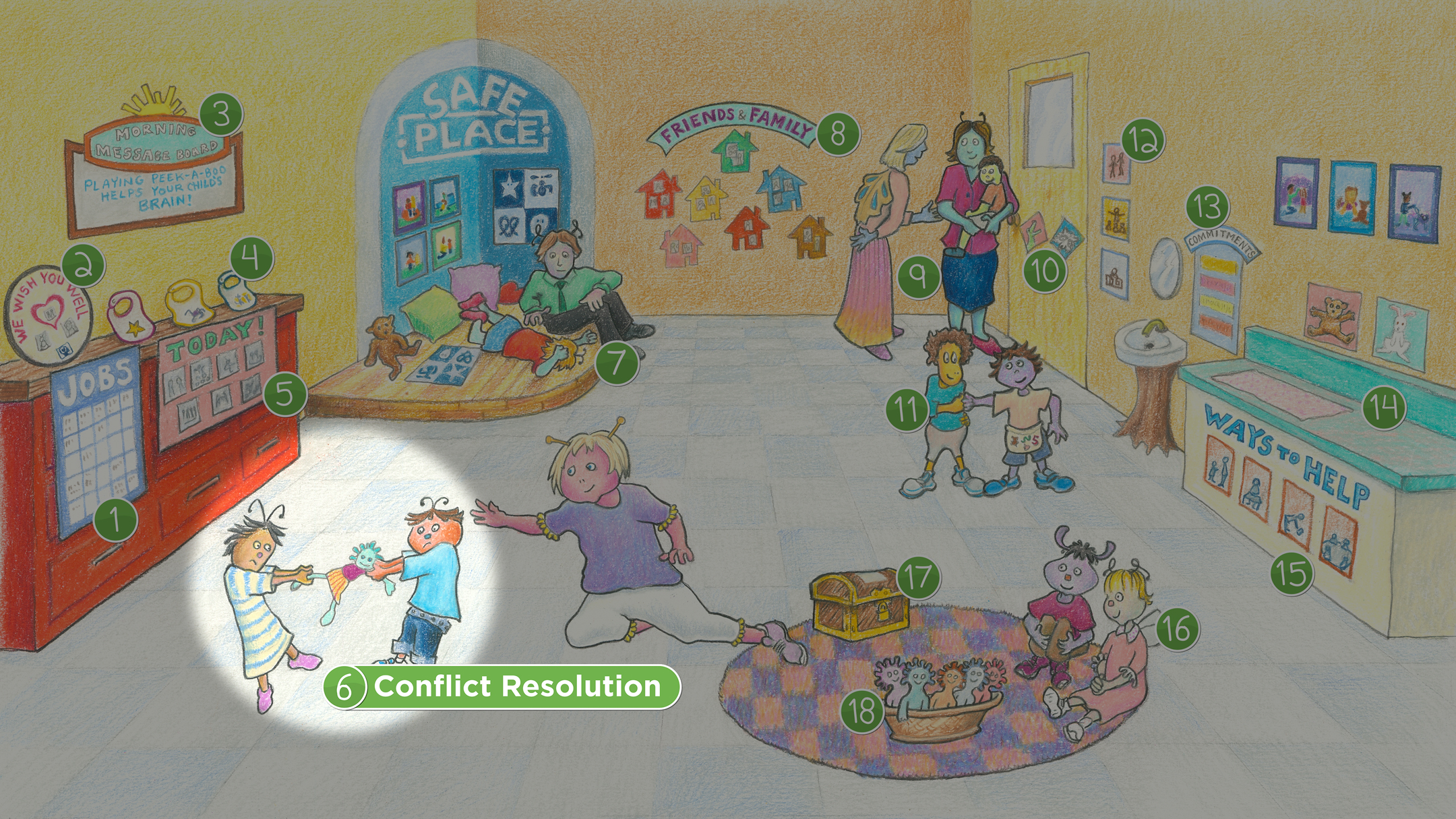Welcome to Shubert’s School
Sophie’s Classroom: Conflict Resolution

- Job Board
- Wish Well Ritual
- Morning Message
- I Love You Rituals Bib Set
- Daily Routine
- Conflict Resolution
- Safe Place
- Friends and Family Board
- Parent Drop Off
- Goodbye Ritual
- Greeting Ritual
- Routines
- Commitments
- Changing Table and I Love You Rituals
- Ways to be Helpful
- Circle Time
- Safekeeper Ritual
- Baby Doll Circle Time
Sophie’s Classroom: Conflict Resolution
How to Use Conflict to Teach in Sophie’s Classroom
0-3 Years
Toddlers’ impulsivity can be a challenge for caregivers, but it’s also the beginning of learning cause/effect and impulse control. Toddlers are not yet able to understand the consequences of their behavior, so adults must set limits that provide safety and teach new skills during conflicts.
Use ACT when setting limits and targeting acceptable behavior.
A – Acknowledge what the child wants or feels
“You were hoping mommy would stay longer.”
“You seem angry.”
C – Communicate the limit clearly, simply and assertively
“Stop. Climbing on the tables is not safe.”
“OUCH. Hitting hurts.”
T – Target acceptable behavior, providing the child alternatives for expressing the original desire/action.
“Stop. Climbing on the table is not safe. You may climb on the stairs or the climber.”
“Stop. Hitting hurts. Touch me like this.” (demonstrate)
3-5 Years
Conflict is an opportunity to teach missing executive or social-emotional skills. The Conflict Resolution Time Machine is designed to help teachers and children transform hurtful acts into life lessons through the use of respectful, assertive communication. It is the hub of your bully prevention program.
There are four ways to introduce the Time Machine:
- During whole group instruction
- During small group instruction
- As students show interest
- When it is needed
Coach children in using the Time Machine as follows:
Step 1: Roll back time. Have the participants and the class (when applicable) roll their hands backwards signifying going back in time.
Step 2: Are you willing? Ask for willingness. “Are you willing to solve the problem so everyone in the class can learn helpful ways?” If willing, the victim stands on the “I don’t like it” side of the mat, and the aggressor on the other side.
Step 3: Breathing star. Be a S.T.A.R. Everyone Smiles, Takes a deep breath And Relaxes.
Step 4: Tree of hearts. Wish each other well. Everyone places their hands on their hearts and offers well-wishes to each other.
Step 5: 1-2-3. Focus on the goal. The adult and/or the class chants, “1-2-3,” and the participants respond, “Let’s do it,” to build unity.
Step 6: Sentence starters. Coach the children to use helpful words. Have the victim speak first using the sentence starter printed on the Time Machine. “I don’t like it when you ____. Next time, please______.” Help children reframe their thoughts to show how they want to be treated. Instead of, “Stop it,” teach phrases like, “Next time say, Move please, instead of pushing me.”
Step 7: Hearts and globe. Connect to repair the bond and show there are no hard feelings. Participants connect with a handshake, a hug, a high-five or other connection.
Chapter 12 of the Creating the School Family book details how to teach and use the Time Machine with children. The NEW Conscious Discipline Updated & Expanded book helps adults identify their assertive voice and use tattling as a teaching tool (the most common way aggressive acts are reported is through tattling). Shubert’s Big Voice is essential in teaching children assertiveness. Read it often and provide opportunities for children to role-play using the Time Machine in group lessons.
Biting
- Try to locate stressors in the toddler’s life: Not enough structure, too much structure, not enough rest, eating, bowel habits, connection, attunement, etc.
- Start a stress reduction program at home and school.
- More touching (skin to skin), body massage games (I am saying goodnight/goodbye to your legs, arms, hands, fingers, head, etc.)
- I Love You Rituals with attuned interactions
- Chest and lap time while downloading calm
- More visual schedules and routines
- Shadowing and teething necklace: There is nothing you can do to help a child learn other ways of getting his or her needs met after the bite has occurred. You must catch the child before the bite. Most bites occur during transitions and non-structured time. Have a person shadow the child who is biting. When the child begins to bite:
- Toss the teething cloth into the child’s open mouth. The mouth will close.
- Say, “You wanted _____(take an educated guess as to what the child wanted). Say _____(acceptable words) or do _____(acceptable action)!”
- Firmly say, “STOP. No bite! Ouch (make pained face) biting hurts.”
- Make visuals of alternatives to biting: My turn, play, move, etc.
- After age three, children usually bite when they feel powerless or scared, such as when they are losing a fight or think they are going to be hurt by another person. Children older than three who frequently bite other people may need to be seen by a doctor. This type of biting may be a sign that a child has problems with expressing feelings or self-control.
| 5-7 months | 8-13 months | 15-36 months | 4+ | |
| Why | Teething or discomfort around the mouth | Overexcited | Stressed, frustrated, as a strategy to get something, often during transitions | Early stressor, tantrums |
| Who | Caregivers | Caregiver or child nearby |
Children | Children or self |
| What To Do |
|
|
|
Seek professional help |
| Message | “My mouth hurts. Help!” | “I’m so excited, I’m over aroused. Help!” | “I know no other way to get what I want or express myself. Help!” | “My clacker is way off. Help!” |
- Job Board
- Wish Well Ritual
- Morning Message
- I Love You Rituals Bib Set
- Daily Routine
- Conflict Resolution
- Safe Place
- Friends and Family Board
- Parent Drop Off
- Goodbye Ritual
- Greeting Ritual
- Routines
- Commitments
- Changing Table and I Love You Rituals
- Ways to be Helpful
- Circle Time
- Safekeeper Ritual
- Baby Doll Circle Time





